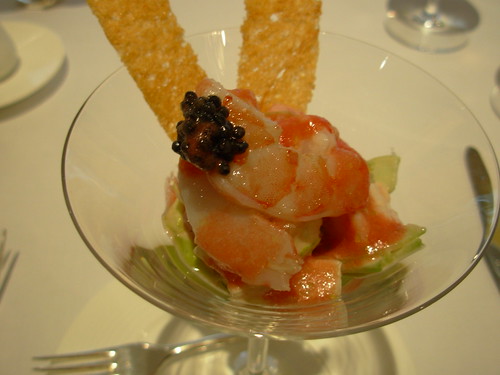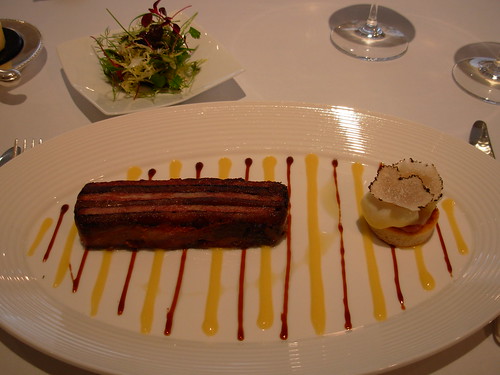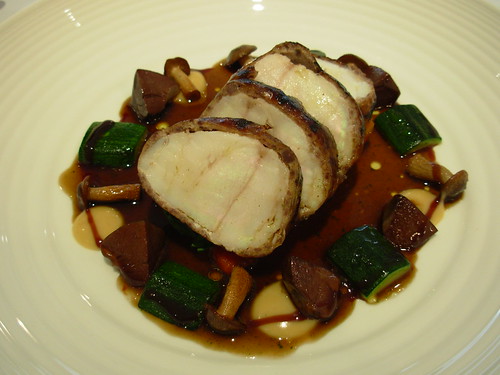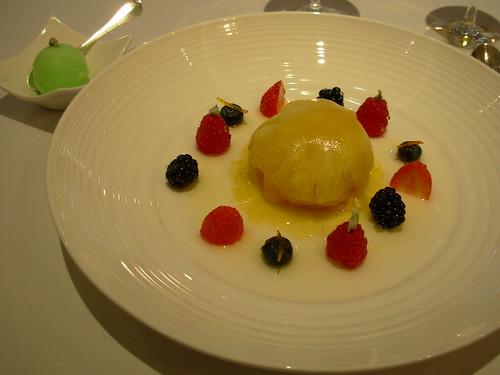When I was studying restaurant kitchens in the Twin Cities in preparation for my book, Kitchens: The Culture of Restaurant Work, I talked with a prominent local chef who explained to me, with some empirical justification, that he believed that his restaurant was the finest establishment between Chicago and the West Coast. I asked whether he could ever compete with those establishments situated in global cities. He doubted it, and I asked why. He answered in two words, “the touches.” By this he pointed to an economic reality of haute cuisine. In second-tier cities, such as Minneapolis-St. Paul there were simply not sufficient diners who would willingly pay for the extra staff to create meals that in their attention to detail that would reveal the chef’s commitment to elaboration, to nuance, to decoration, and to luxe.
Gordon Ramsay has no such trouble. (His troubles are reputed to be otherwise, including those of class cultures, as detailed by sociologist Pierre Bourdieu in his accounts of how one’s class background affects one’s interactional style. This forgets that until recently cooking was a job for the lads.) But touches Ramsay has in spades. Ramsay can gather as much staff as he can stuff into his kitchen, both because of the elasticity of his prices and because of the willingness of ambitious culinary tots to stage (star-jzay – or intern) with him, hoping that glorious gustatory dust may rub off. At a recent lunch the touches were much in evidence. And on the floor an army of staff paced, watching for the wayward crumb. This was a salutary surveillance, but surveillance none-the-less.
Gordon Ramsay, one of the most proficient, and often inspired, chefs, suggests that perfection while surely admirable, can have the feel of being frozen in amber, perhaps not always the best advertisement for a cuisine whose cutting edge is hyper-modern. This problem is all-too-common when outstanding chefs leave the stove behind and become overlords. This doesn’t discount the real contributions of the chef de cuisine, but major changes at such workshops require the approval of the masters, a culinary bureaucracy that limits spontaneity. Still, it is hard to have a bad meal at Ramsay’s or even a mediocre one.
One change from my previous visit was the color scheme: the deep, rich plum walls were gone, replaced by creams and silvers and blacks. With the plum went something of the adventure of space, replaced by a more serious, more carefully modulated environment. I preferred the plum.
As amuse I was served a tiger prawn cocktail with Osetra caviar, gazpacho, croutons, mashed avocado, tomato, and cucumber. This starter was a high-end shrimp cocktail that would have been somewhat pedestrian, if tasty, had it not been for the cucumber. This modest bit of salad added the dish a cool, summery lushness – a subtle, slightly sweet, slightly herbal moistness that created an unexpected and welcome taste.

The appetizer revealed just how far the influence of Fergus Henderson of St. John has traveled: from Smithfield Market to the heart of Chelsea. Slow-braised pied de cochon (pig’s trotter) pressed then pan-fried with ham knuckle – and an “egg benedict” with quial’s egg and hollandaise sauce – decorated stripes of Hollandaise and Balsamic sauce – was a creation that very elegant indeed, a work of art, but also a workingman’s craft: haute slaughterhouse. This was the highlight of the meal, and one of the grandest dishes of my British tour: Fergus Henderson waltzing in tux and tails.

As a main course I selected chargrilled monkfish tail wrapped in duck confit with courgette (zucchini) and duck gizzard (Fergus again), served over petite squares of red and yellow peppers, tiny Japanese mushrooms, and red wine jus. It was an elegant presentation, perhaps a little heavy, but hardly a combination about which one could quibble. The tastes blended well, but in total were less startling than the remarkable appetizer.

As a palate cleanser, I was served a raspberry compote with lemongrass crème – a bistro dissert with its admirable crackly coating. The lemongrass was unfortunately overwhelmed by the raspberry – I would have used pear instead. But I daydreamed of Heston Blumenthal testing us with durian crème, a combination that I lust to try with equally intrepid dining companions.
The main dessert was pineapple ravioli with berries, filled with passion fruit, and served with a dense mint sorbet (the later seemingly an alien from some other course). While tasty, the ravioli packaging didn’t quite hold up and the filling squirted about, creating a sweet that was a challenge to eat.

Finally strawberry ice cream balls wrapped in white chocolate: perhaps somewhat icy, but intense in flavor.
Some chefs create their own distinctive style, whereas others, equally creative, are synthesizers, and it is in the latter camp that both of the meals that I have had at Ramsay’s fall. His staff is proficient and smooth and unfailing. Yet synthesizing produces meals that are only outstanding, not life-changing. Yet, some afternoons outstanding is quite enough.
Gordon Ramsay
68 Royal Hospital Road
London (Chelsea)
+44 (0)20-7352-4441
http://www.gordonramsay.com/royalhospitalroad/

2 comments:
Hi Gary!
I just found your site!
Post a Comment